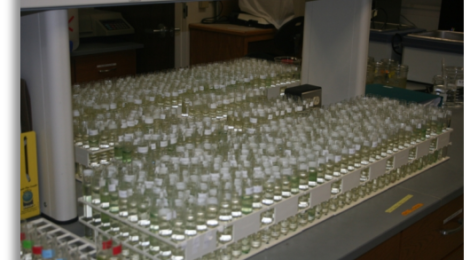
Aging in fluctuating environments
Above Test tube habitats for individual D. magna raised under different food resource fluctuation schemes
How individual organisms modify their life trajectories to cope with fluctuating environments and how populations fluctuate as individuals with different life history strategies are selected are fundamental questions in the theory of life history evolution. Encompassed within this framework are questions about the evolution of senescence, allocation of reproductive effort over the life span, and variation in fitness among individuals. As we have sought to understand the dynamics of population extinction – and particularly the role of demographic stochasticity – it has become necessary to understand the demographic consequences of these evolutionary forces. Particularly, for the experimental Daphnia system:
- What is the variation in individual lifespan of lab-reared Daphnia magna?
- Is the hazard function for individual mortality constant or age-dependent?
- Do population density and other environmental factors modify mortality hazard?
- Is reproductive bet-hedging more evident in fluctuating environments than in constant environments?
- Do fluctuations impose a lifetime fitness cost?
- Is variation in reproduction controlled by the mother? If so, how? To what cues is she responding?
In designing an experiment to answer these questions we came across a neat theoretical paper by Weitz & Fraser (2001). The inspiration for the Weitz-Fraser model is the recent finding that many species exhibit late-life mortality plateaus. Weitz and Fraser showed that late-life mortality plateaus are a natural consequence of stochastic fluctuations in a theoretical quantity they called “viability”. Reasoning that viability (whatever it is) might fluctuate in response to an environmental driver, it’s a simple step to conclude that environmental fluctuations might drive late-life mortality plateaus in natural populations.
To answer these questions and provide an empirical test of the Wetiz-Fraser model student Katie McCurdy executed the first of a series of experiments in which individual Daphnia magna were reared from birth to death with individually applied experimental treatments. These experiments are now ongoing and we hope that the results will not only answer the demographic questions posed above but also might shed light on basic theories in life history evolution and the evolution of aging.





